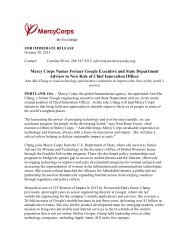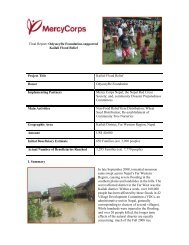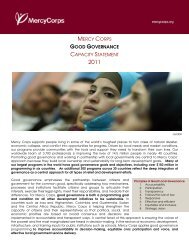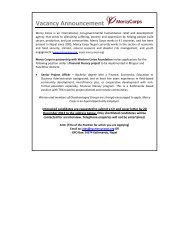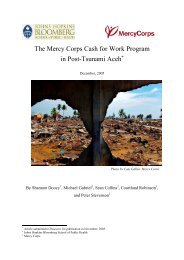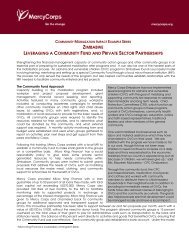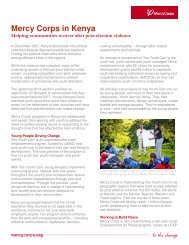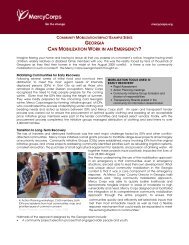Program Management Manual - Mercy Corps
Program Management Manual - Mercy Corps
Program Management Manual - Mercy Corps
Create successful ePaper yourself
Turn your PDF publications into a flip-book with our unique Google optimized e-Paper software.
<strong>Program</strong> <strong>Management</strong> <strong>Manual</strong>Chapter 4The Set Up and Planning Phase1. What is the probability of the risk event occurring?2. What would be the impact on the program if the risk event were to occur?3. What steps can be taken to minimize the impact of the risk event if it did happen?Answering the third question provides your risk mitigation strategy for each risk. You then need to decide for each riskwho will implement the strategy, with which resources and by when. See the Risk <strong>Management</strong> Tip Sheet in Annex5 for steps of risk management planning.Review your risk log on a regular basis, adding new risks as they occur during the life of the program. Remember,when risks are ignored they don’t go away.Risk <strong>Management</strong> is an iterative activity performed throughout the entire duration of the program. In essence the<strong>Program</strong> Manager is a risk manager. The PMO and <strong>Program</strong> Team should be constantly anticipating what couldimpact the program and how to avoid or mitigate those impacts keeping the project moving forward, as per the“Managing Issues” section of Chapter 5. An initial Risk Assessment should be done in the proposal phase so highprobability and severe risks can be incorporated into the proposal plan (contingency or mitigation planning). Thisinitial Risk Assessment should now be re-assessed in the planning phase, when there is more information and alarger cross-functional team is available for input.Plan for Quality AssuranceDescriptions of individual program deliverables form the basis for quality assurance. Descriptions of deliverables arecreated by the <strong>Program</strong> Team throughout the <strong>Program</strong> Implementation phase, on an as needed basis, not all at once.Examples of descriptions of deliverables include:• Training agendas, materials, and facilitators’ notes for trainings• Design drawings and Bill of Quantities for infrastructure• Scope of Work or Terms of Reference for technical consultancies• Approach and process documentation (for example, a community mobilization process, or nutrition rehabilitationprocess, or a farmers’ capacity building process)Ensure that a relevant <strong>Program</strong> Team member is assigned to develop each of these descriptions of deliverables, andthat these are approved by the <strong>Program</strong> Manager as they are developed.All programs require quality checks either through an M&E process or through quality assurance checks or both.During the course of implementation, quality assurance checks should be conducted, and should be included withinthe <strong>Program</strong> Schedule in the PWP, and should be carried out by someone outside of the direct <strong>Program</strong> Team.An example of what is described above is summarized in the table below:DeliverablesDescription of DeliverablesQuality Assurance Checks1,000 latrinesPlan for Monitoring and Evaluation (M&E)Standard latrine drawing and Bill of QuantitiesVisits during and after construction to confirm the total number of latrines(physical verification), and the actual design of the latrines as compared to theplanned design within the description of deliverablesMonitoring and Evaluation Processes compare program performance to the objectives and indicators in the originalproposal, as well as to the <strong>Program</strong> Work Plan and Indicator Plan. M&E data are actively used through the <strong>Program</strong>Implementation phase to track that the program is achieving desired results. If there are unacceptable variances,Monitoring and Evaluation results can be used to make adjustments to program plans through a change process(see Chapter 5). Based on the degree of change, elements of the PWP may need to be updated to reflect the newactions.Planning for effective M&E begins in the <strong>Program</strong> Identification and Design phase by incorporating SMARTobjectives (see section 3.6) and well thought-out indicators into the program logframe. Implementation plans arethen developed in the planning phase. A well-developed M&E plan can take time to develop and the design shouldmercycorps.org < Table of Contents 35



